Thin-leaved marigolds - crimson carpet of the autumn garden
Autumn is a time of transformations in nature, when warm golden hues replace bright greenery. At this time, the fiery heads of marigolds look especially impressive on the flower beds.
Content
Marigolds: general portrait
Flowers belong to the genus of perennial and annual plants from the Astrov family. Their homeland is South and Central America. Russia's acquaintance with overseas flowers began precisely with this culture.
The appearance of the plants was appreciated by Karl Linnaeus, who named them after Tages, a mythical demigod who became famous for his beauty. Indeed, the wonderful flowers are appreciated in many countries. In Ukraine, they are black-haired people, praised in folk art. Poles and Belarusians call marigolds "aksamitki", and Russians call them "marigolds" or "merchants".
Science knows about 40 representatives of the Tagetes genus, but only three are especially popular among gardeners. Among the favorites are thin-leaved or Mexican marigolds.
The height of the globular bushes is 40 cm. The diameter of the inflorescences is 2 cm. The flowers have a strong root system; adventitious roots develop on the lower part of the stem.
Plants decorate the garden with bright lights from late spring to the very frost. Ripe seeds retain their properties for 2-3 years.
A distinctive feature of these colors - delicate lacy foliage, spreading a pleasant aroma. The numerous but small inflorescences are just golden fireworks. Their palette is reddish-orange, rich yellow and orange shades.
Today, there are approximately 70 varieties of fine-leaved marigolds.
The recognized favorites among them are:
- Gnome
- Mimimix
- Golden Jam
- Paprika
- Ursula
- Karina orange
Tagetes is a graceful flower, the delicate leaves of which create the effect of lightness, weightlessness of the bush.
Growing marigolds
Propagating a culture is not difficult at all. In a warm homeland, she is a perennial. The climatic conditions of the middle latitudes are such that the flower is not able to survive the cold winter in the soil. But he generously throws out seeds that remain viable and germinate on their own in the spring in the same place.
The easiest way to propagate marigolds is to sow the harvested raw materials in open ground.
They work in May, because by this time the soil will warm up enough. After drawing a groove (depth 5 cm) and watering it with water, planting material is sown. Then they sprinkle it with earth. After about 14 days, sprouts will appear. If the seedlings are too dense, they are planted.
A more complex cultivation option is growing seedlings marigolds fine-leaved. Getting seeds for work is as easy as shelling pears: let a few inflorescences dry well right on the bush. Ripe planting material will easily detach from the cup. In order for the seedlings to appear as quickly as possible, you need to work on the seeds. They are germinated by spreading them out on a dish and covered with a damp cloth. The dishes are placed in a plastic bag and kept warm. In comfortable conditions, the seeds will hatch in 3 days.
Seedlings begin to grow in early spring. Technology:
- Prepare the substrate. Combine 1 part of humus, peat, turf with 0.5 parts of sand.
- Conduct disinfection. Water the soil with a concentrated solution of potassium permanganate.A fungicide can be used as a disinfectant.
- Build a drainage (height 3 cm) from crushed stone, sand or expanded clay.
- Apply any organic fertilizer. Do not use fresh manure.
- Draw grooves, maintaining a distance of 1.5-2 cm.
- Spread the seeds.
- Sprinkle lightly with soil.
- Place the containers in a warm place (22-250C).
- Water the plantings very carefully, otherwise the seeds may be washed out with water. After the emergence of sprouts, the containers are transferred to the light in a cooler place.
At home, marigolds are propagated by sowing planting material harvested in the fall into open ground.
Culture care
Care Tips:
- Tagetes will feel normal both in the sun and in a shaded place. In an open area, its flowering will be especially lush.
- The bushes will not like stagnant water, although during the period of active growth they prefer moist soil. In a drought, the plant is watered in the evening.
- Excessive enthusiasm for fertilizing will postpone flowering to a later period. The plant will throw out more new inflorescences if old ones are plucked in time.
- Weeding, loosening the soil let the marigolds breathe. They are good for summer pruning: the shape of the bushes becomes more decorative.
The specific aroma of the plant and the phytoncides in its composition are protection from fungi both for the flowers themselves and for their closest neighbors. Mulch can be prepared from dried bushes harvested in autumn. In the soil cultivated by it, no parasites will start.
Thin-leaved marigolds in terms of care are not at all capricious.
Tagetes is a golden fragrant decoration that looks pretty both on a flower bed and on a vegetable garden. A special charm in the generosity of the plant: from each flowering bush, you can collect many seeds that remain viable for a long time.
More information can be found in the video.



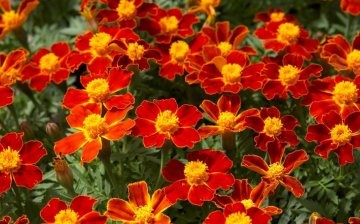
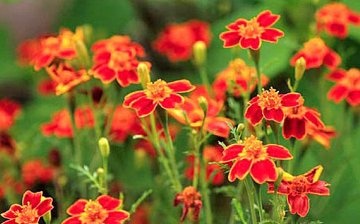
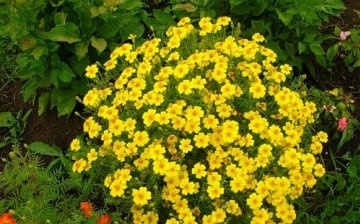
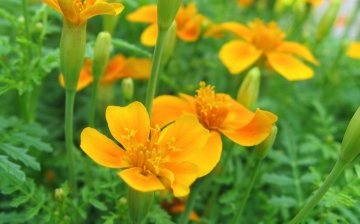




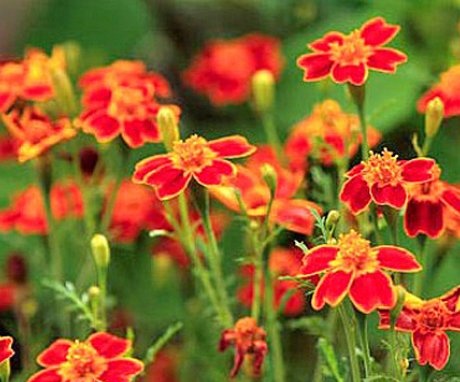
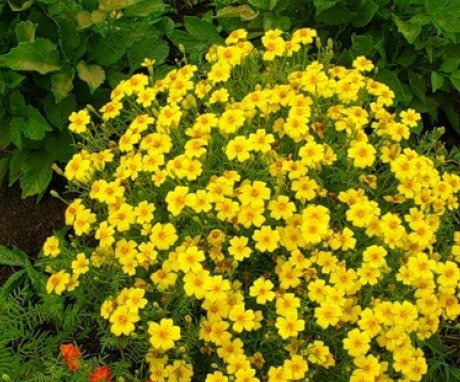

Marigolds will look beautiful in any private or summer cottage. Such bright colors immediately catch the eye, and in the fall, when everything fades, they will be the most noticeable on the site.